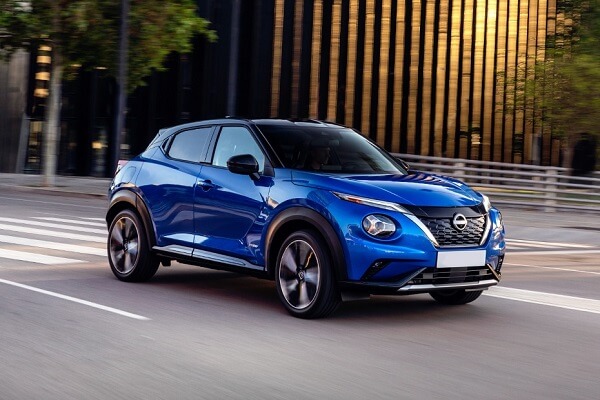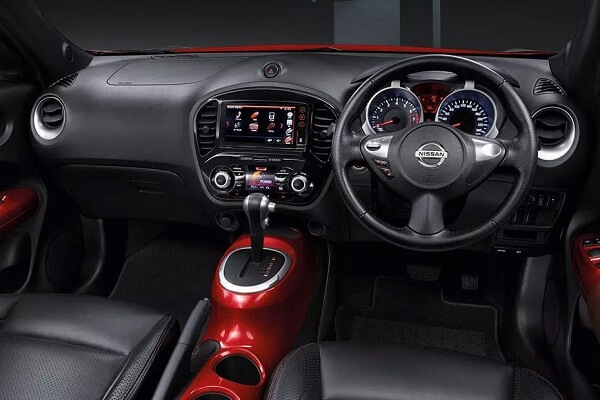Nissan Juke ReviewIntroductionThe Nissan Juke was a pioneer when it was introduced. It was developed as an alternative for small cars and is available on an affordable budget. The Juke is being sold in large numbers and it served as an inspiration for several small SUVs, despite its unique design not being liked by everyone. There were few issues with its design in its oldest model but now the most recent model fixes every problem with the vehicle and offers far superior all-around performance. Nissan Juke models that cost less have 1.0-litre turbocharged petrol engines, but by spending a little more money, you can purchase a 1.6-litre petrol hybrid version. This model can run only on electricity and helps to compete well on fuel efficiency and refinement with the Toyota Yaris Cross alongside other electrically-assisted rivals. Regarding competitors, there are also the Ford Puma, Renault Captur, and VW T-Roc. 
Review1. Performance and Drive The Juke engine comes out with our preferred 112 brake horsepower and 1.0-litre turbocharged petrol engine (badged DIG-T 114), which is sufficient as long as you maintain revs over 2000 rpm. Nissan claims that the 0-62 mph sprint will take 10.7 seconds, but it will take a lot of effort to even come close to that. Comparable engines in the competing range of cars, the VW T-Roc and Skoda Kamiq are more powerful. The 141bhp 1.6-litre hybrid is the top model available in the market. It can accelerate from 0 to 62 mph in 10.1 seconds, competing with the Toyota Yaris Cross. While it can travel beyond 15 mph on electricity alone, it performs best when the engine electric motor are working together. 2. Suspension and Ride comfort It does not give a smooth ride and jumps at any smaller bumps on faster roads. For the best comfort, people recommend avoiding the - alloy wheels fitted to Tekna as well as Tekna+ trims and sticking with the smaller 16-inch or 17-inch alternatives you get with lesser trims. Still, no version that comes with the Juke is as easy-going a ride as the base model. The settings are slightly different for the heavier Hybrid. People pick smaller 17-inchwheels in place of the larger 19-inch wheels that come with an "aero" design. In comparison to the larger standard wheels, the ride is more uncomfortable at low speeds during the initial impact with potholes and speed bumps if you use 17-inch wheels. In this regard, the Yaris Cross is recommended. 3. Handling The Juke has a high stance, but it doesn't swing as much through sharp turns as you might think, and sufficient grip is present. The steering, though, is too eager to flick back to the centre, almost as if it were winding an elastic band, so it's not that much fun. As a result, you lose a lot of self-assurance connection with the road. On the other hand, the Puma is the best-driving small SUV by a wide margin. The Puma has superior body control over bumpy roads, heavier and more alert steering and bends feel lighter and playfully balanced. 
4. Vibration and Noise The Juke's 1.0-litre petrol engine is quieter as compared to Kamiq and T-Roc, however, when you drive vigorously, the turbocharger does make an odd whistling sound. When the Hybrid is only using electricity, it is even quieter, but if you ask it to accelerate quickly, the 1.6-litre petrol engines relatively produce coarse tone will disturb the peace. The Puma, Kamiq, and T-Roc are easier to drive in stop-and-go traffic than the six-speed manual transmission vehicles, whose shifts are notably more precise. No matter what drive mode you're in, the seven-speed dual-clutch automatic is avoided because it is jerky when you set off. Unfortunately, the Juke catches up to quite a bit of wind and traffic noise. The massive 19-inch alloy wheels that come standard on the top trims as well as the Hybrid increase the road noise. 5. Interior If you've ever driven a 2010-2019 Juke, you may have been disappointed that the steering wheel could only be adjusted for height (not reach). You'll feel happy to learn that the steering wheel now also slides in and out since that can be an advantage for certain drivers. The Juke's LED headlights are standard on all models, which improves visibility on the road at night. Junction views are also pretty good while looking forward and diagonally. Less incredible is the view behind you, which is less clear than in other same-ranged cars like the Kamiq. The Juke's large rear pillars and progressively sloping back windows are an issue. The Nissan Juke has a nice interior without a doubt, but its old-fashioned comfort and safety function are not much good. The Juke's cabin is particularly attractive because it is modern, fashionable, and well-made. Its only weakness is the safety system, which is not up to the safety of people. Even the Nissan Juke's interior appears not good compared to other competitive cars despite its unique external style. The construction is decent, and there are many areas where you'll observe scratchy plastics. The Nissan Juke comes with a simple radio as standard equipment, while all subsequent models come with an 8.0-inch infotainment system. When the Juke was first introduced in 2019, this was one of the bestselling vehicles, but it feels quite outdated. Modern systems look better and operate better as compared to older ones. The fact that it has Apple CarPlay and Android Auto installed means you can use your phone's apps without interruption on the screen. 6. Practicality It feels a little uncomfortable inside the Juke, even though you sit up quite high, providing you with a good view out the front. It's not unpleasant, but vehicles like the Skoda Kamiq Volkswagen T-Cross might interest you more if you want more space to spread around. However, you can find some good storage areas. The door bins can hold a good-sized water bottle, and the centre desk has a tray for storing your phone, though larger phones might have trouble fitting. 7. Back-Seat Space The new Nissan Juke has slightly less space in the back than the previous model, but it still can be considered. Passengers may not prefer a long ride because its backspace is not having enough space, children might feel comfortable there but adults cannot. Legroom is not up to mark, and headroom is also noticeably reduced by the slanted roofline. Anyone sitting in the middle seat won't have anywhere to put their feet due to the floor's huge hump. 8. Reliability There isn't much information available on the usual problems because the manufacturer warranties on the early Nissan Jukes are just about to expire. Each Juke comes with a three-year, 60,000-mile guarantee from the company. 9. Price The beginning pricing of the Nissan Juke appears to be fairly competitive with the Skoda Kamiq's entry-level SE grade. The most luxurious trims cost more as you go high in the range, putting the Juke in the same pricing range as the VW T-Roc. Although not class-leading, fuel efficiency CO2 emissions are decent. The Yaris Cross easily defeats the Juke Hybrid, while a Ford Puma with a mild-hybrid engine sets the bar for efficiency among small SUVs. The Skoda Kamiq and T-Roc are going to decline more slowly than the Juke, which is likely to retain its value significantly better than the Citroen C3 Aircross. Pros
Cons
ConclusionThe Juke excels in a few crucial categories, such as interior quality, safety, as well as equipment levels, but the small SUV segment offers a greater number of options. One is the Skoda Kamiq, which is notably superior if you're looking for comfort or space, though the incredible Ford Puma ought to be more affordable to operate and far more comfortable to drive.
Next TopicToyota Hilux First Drive Review
|
 For Videos Join Our Youtube Channel: Join Now
For Videos Join Our Youtube Channel: Join Now
Feedback
- Send your Feedback to [email protected]
Help Others, Please Share









